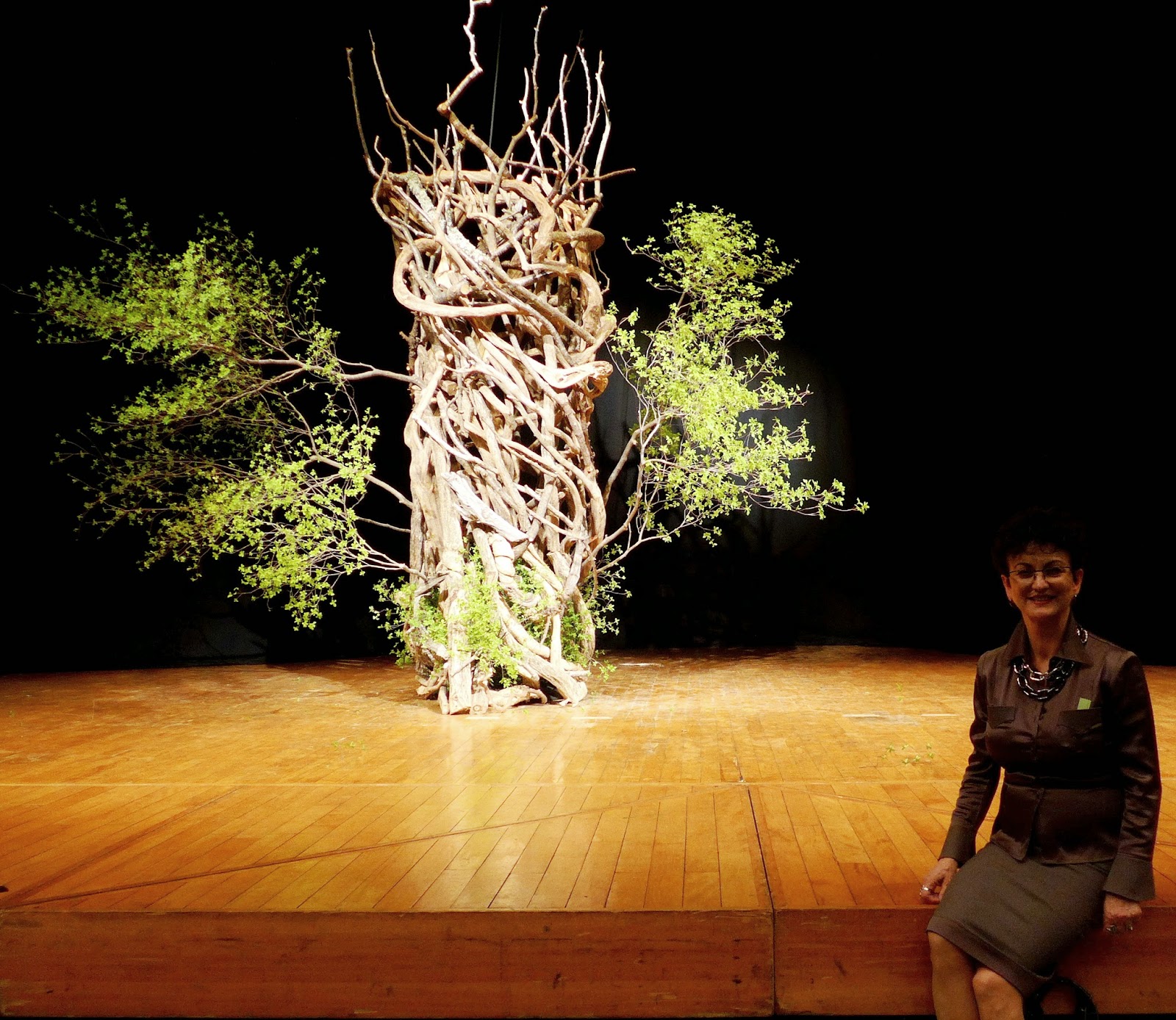Arrangement in Japanese room by Tomita Soko
The theme for the first was 'Composition of Straight Lines'. I chose red willow and chrysanthemums in an interesting container, which continued the 'lines' theme.
Eikou Sumura sensei approved of all aspects of the arrangement but suggested I trim the little knobs from the stems of the chrysanthemums. I must admit I had left them on intentionally, as I found them interesting but she is the teacher and I the pupil so I attempted to remove the knobs where the leaves had been but they wouldn't come off cleanly and there was no time to scrape them all off.
Sensei used alstroemerias and New Zealand flax in a container that worked perfectly with her design.
The second and third Iemoto classes had the same theme - 'Composition of Straight and Curved Lines'. In the first, I used kiwi vine and hostas (that looked like they were on steroids) in this interesting container. Sozan Nakamura sensei was very pleased with this arrangement pointing out the importance of the space between the hostas being straight.
Front View
Side view
Sensei also used hostas for the straight lines with bull rush leaves which he manipulated and an unusual lily at the base.
For my second 'Composition of Straight and curved Lines' I used New Zealand flax, which I split and twisted and sun flowers. Gaho Isono sensei approved of the arrangement and container and the fact that I kept some leaves on the sunflowers. She also gave me a little tip to help preserve the leaves of sunflowers. After cutting under water, dip the stem into salt and then arrange.
Sensei used kangaroo paw, which she trimmed to emphasize the straight lines. For the curves she used New Zealand flax, which she had curled a couple of days earlier and held with a clip and then released creating these interesting curves.
The fourth Iemoto class had the theme 'Composition of
Curved Lines'. As I looked at the selection of materials available I,
instinctively, reached for bendable material that would easily create curved
lines. Tamae Eguchi san, who was assisting in the classroom made a suggestion
that ' it's ok for now but in future choose the materials you don't like'. It
was on the tip of my tongue to say that there are no materials I don't like but
I realized what she meant was that I should choose more challenging materials.
I, however, didn't wait for 'the future' but went immediatly and
exchanged my materials for one very full and bushy Japanese maple branch and
fennel. I tested the maple and it wouldn't bend, so I created curves by
removing branches and leaves so that what was left created a curve. To bend the
thicker part of the stem I cut into the bark at intervals and very carefully
bent it without snapping.
Then I tried the fennel. No, it certainly would not bend
because it has a hollow stem and would kink. I had to find a way to add some
curve so I tried inserting a wire into the stem and gently bending. That did the trick. And
now it was just a matter of arranging them. I was happy with the end result but
I was even happier with the fact that I tried something new and that it worked.
I'm grateful to Tamae-san for her suggestion and I intend to put it into
practice more often.
Somewhat surprisingly for me, both sensei and Tamae-san
really liked my arrangement and sensei was so impressed she wanted to know my grade.
Front view
Side view
For the next class and having learnt from the previous one, I felt more
confident about my choice of materials, although, I again had only two types of
leaves. I used palm grass (Curculigo) and variegated New Zealand flax which I
split from the bottom but left intact at the top, then threaded through the
palm grass.
This has been a very long post and I thank you for
reading all the way through.
Side view
Junga Shinozaki sensei's arrangement using contorted willow and calla lilies
The last two Iemoto classes for May had the same theme -
'With Leaves Only' and, again, they provided a good learning experience for me.
Seiko Ozawa sensei was the instructor for the first. I
chose a bunch of cycads and a bunch of bulrush leaves, which I felt were
appropriate. I know that this exercise requires more than two types of leaves but we can
only choose two materials per class so I had to make do.
Half way through my arrangement, Misei-san, who was
assisting whispered in my ear that the long, thin leaves were not appropriate
because they create 'line' rather than 'surface'. It was too late to change and I
continued with my original idea.
Ozawa sensei approved of the composition but suggested
that, since I had a large container, I should move the leaves more to the left within
the container and to extend the line to the right.
Before correction
After correction
When Ozawa sensei demonstrated this theme she used three
types of leaves - a large philodendron, several aspidistra leaves that she
stripped, and brown-coloured flax in a stunning glass vase. A very pleasing
arrangement.
The arrangement pleased Bisen Sumide sensei and she
pointed out that in this theme it is important to change the character of the
material and that I had achieved that whilst making a beautiful arrangement.
For her demonstration, Sumide sensei used two suibans, a
black one upside down and a white one on top of it, right side up. She
explained that she was about to make a large arrangement so this way she
enlarged the container. She used two rather heavy monstera leaves, which she
managed to balance resting them against each other and added variegated hostas
and some brown coloured tropical leaves.
Until next time,
Emily



























































